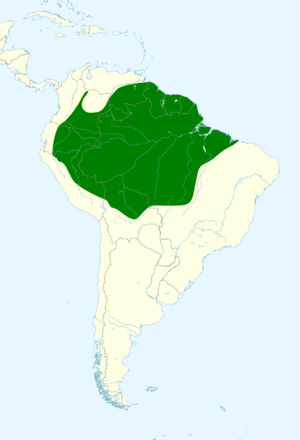Red-necked woodpecker facts for kids
Quick facts for kids Red-necked woodpecker |
|
|---|---|
 |
|
| A female red-necked woodpecker in Alta Floresta, Mato Grosso state, Brazil | |
| Conservation status | |
| Scientific classification | |
| Genus: |
Campephilus
|
| Species: |
rubricollis
|
 |
|
The red-necked woodpecker (Campephilus rubricollis) is a type of bird from the woodpecker family. You can find it in many countries in South America. It lives in places like Brazil, Colombia, Ecuador, Venezuela, and Peru.
Contents
About the Red-necked Woodpecker
What's in a Name?
The red-necked woodpecker got its scientific name, Campephilus rubricollis, a long time ago. A French scientist named Georges-Louis Leclerc, Comte de Buffon first described it in 1780. Later, in 1783, a Dutch scientist named Pieter Boddaert gave it its official scientific name.
The name Campephilus comes from ancient Greek words. Kampē means "caterpillar" and philos means "loving". So, it means "caterpillar-loving". The second part of the name, rubricollis, comes from Latin. Ruber means "red" and -collis means "-necked". This perfectly describes its red neck!
Different Kinds of Red-necked Woodpeckers
There are three slightly different types, or subspecies, of the red-necked woodpecker:
- C. r. rubricollis
- C. r. trachelopyrus
- C. r. olallae
These subspecies look a bit different and live in different areas.
What Does It Look Like?
The red-necked woodpecker is a medium-sized bird. It is about 30 to 35 centimeters (12 to 14 inches) long. It weighs between 178 and 236 grams (6.3 to 8.3 ounces).
Colors and Markings
Most of its upper body is black or brownish-black. Its wings are black on top, but the inner parts of the flight feathers are reddish-brown. The underside of its wings is reddish-brown with black edges. Its tail is black.
The lower part of its body is bright red on the chest. This color changes to a reddish-brown towards its belly.
Males and Females
Male red-necked woodpeckers have an entirely red head and neck. They have a small black and white spot near their ear feathers. Female woodpeckers do not have this spot. Instead, they have a wide whitish stripe with black edges. This stripe goes from their beak to their ear feathers.
Their beak is long and looks like a chisel. It is pale grayish-white or ivory. Their eyes are yellowish-white, and their legs are dark gray or olive.
Young Woodpeckers
Young woodpeckers look similar to adults. However, their colors are not as bright. Their red parts are more orange, and their other colors are duller and browner.
Subspecies Differences
The C. r. trachelopyrus subspecies is larger and darker than the main type. Its underparts are more chestnut-colored than red. The C. r. olallae subspecies is in between the other two in size and color. Its red and reddish-brown colors are brighter than trachelopyrus but not as bright as the main type.
Where Do They Live?
The red-necked woodpecker lives in the Amazon Basin. This is a huge area around the Amazon River in South America.
Habitat
These woodpeckers prefer to live deep inside rainforests. They also live at the edges of forests. You can find them in areas where forests are regrowing. They also live in woodlands along rivers in grassy areas called savannahs.
They usually live from sea level up to about 600 meters (2,000 feet) high. But sometimes, you can find them higher up. In parts of Venezuela and Brazil, they can be found up to 1,800 meters (5,900 feet). In Bolivia, they can even reach 2,400 meters (7,900 feet).
Behavior
Movement
Red-necked woodpeckers do not migrate. They stay in the same area all year round.
Feeding Habits
These woodpeckers usually look for food on tree trunks and large branches. They search from the middle of the forest all the way up to the treetops. Sometimes, they also look for food closer to the ground on old, rotting tree stumps.
They often forage in pairs or small family groups. Their diet mainly includes the larvae (young forms) of beetles and moths. They also eat some fruit.
Reproduction
Red-necked woodpeckers breed at different times of the year depending on where they live. In the northern parts of their range, they breed between January and May. In Ecuador, it's around November, and in Peru, it's September.
They make their nests inside holes they dig in dead trees or palm trees. These nests are usually high up. They are thought to lay about two to four eggs. Not much else is known about how they raise their young.
Sounds They Make
The red-necked woodpecker has a very distinct call. It's often described as an "explosive nasal call" like ngkah-ngkah or kikka. They repeat this call many times. When they are upset, they make "churring calls" like ca-wa-rr-r.
They also make drumming sounds by tapping their beaks on trees. Their drum is a loud double-rap. When they are looking for food, their tapping sounds can vary in how loud they are. Their wings can also make noise when they fly.
Status
The IUCN (International Union for Conservation of Nature) has listed the red-necked woodpecker as a species of "Least Concern". This means they are not currently in danger of disappearing.
They live across a very large area. However, the total number of these woodpeckers is not known. Scientists believe their population might be slowly decreasing. There are no immediate big threats to them. But, their forest homes are shrinking because of deforestation. This happens when forests are cut down or changed into farms or tree plantations.


